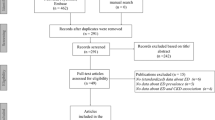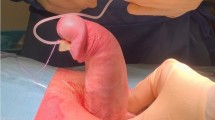Abstract
Objective
Only a single study investigated erectile dysfunction (ED) among patients with chronic brucellosis without including a control group. Our study objective was to determine the prevalence of ED among patients with chronic brucellosis compared to normal subjects, and to explore the predictors of ED.
Materials and methods
We included 93 chronic brucellosis patients and 92 subjects as a control, from June 2013 to August 2017. Chronic brucellosis was diagnosed based on persistent symptoms for ≥1 year with positive immunoglobulin G antibody titer (≥1:160) by standard tube agglutination test; the mean duration was 21 ± 6.2 months. Clinical evaluation (including an Arabic validated version of the five-item International Index of Erectile Function to diagnose ED; score of 5–21 was diagnostic), imaging studies (including scrotal ultrasonography) and laboratory investigations (including estimation of fasting serum level of glucose (after fasting for 8 h), lipids profile (after fasting for 14 h), and serum level of testosterone) were conducted. A fasting serum glucose level of ≥ 7 mmol/L defined diabetes mellitus (DM). Predictors of ED were identified using multivariate analysis (binary logistic regression).
Results
The mean age of patients was 35.4 ± 13.7 years; 24.7% of them had DM, while low serum level of testosterone was detected among 54.8%. Among the patients, ED was significantly more frequent compared to the control subjects (69.9% vs. 19.6%, p < 0.001). Low serum level of testosterone (OR 4.8, 95% CI 1.7–29.3, p 0.008), and DM (OR 3.5, 95% CI 1.2–34.6, p 0.011) were the predictors of ED among the patients.
Conclusions
The prevalence of ED among patients with chronic brucellosis is high. Low serum level of testosterone and DM are associated with ED among such patients.
This is a preview of subscription content, access via your institution
Access options
Subscribe to this journal
Receive 8 print issues and online access
$259.00 per year
only $32.38 per issue
Buy this article
- Purchase on Springer Link
- Instant access to full article PDF
Prices may be subject to local taxes which are calculated during checkout

Similar content being viewed by others
References
Pappas G, Papadimitriou P, Akritidis N, Christou L, Tsianos EV. The new global map of human brucellosis. Lancet Infect Dis. 2006;6:91–99.
Hussein AA, Sayed AS, El Feki MA. Seroepidemiological study on human brucellosis in Assiut Governorate. Egypt J Immunol. 2005;12:49–56.
Pappas G, Akritidis N, Bosilkovski M, Tsianos E. Brucellosis. N Engl J Med. 2005;352:2325–36.
Navarro-Martínez A, Solera J, Corredoira J, Beato JL, Martínez-Alfaro E, Atiénzar M, et al. Epididymoorchitis due to Brucella mellitensis: a retrospective study of 59 patients. Clin Infect Dis. 2001;33:2017–22.
Shamloul R, Ghanem H. Erectile dysfunction. Lancet . 2013;381:153–65.
National Institutes of Health. Consensus development conference statement. Impotence. December 7-9, 1992. Int J Impot Res. 1993;5:181–284.
Nicolosi A, Glasser DB, Kim SC, Marumo K, Laumann EO. GSSAB Investigators’ Group. Sexual behaviour and dysfunction and help-seeking patterns in adults aged 40-80 years in the urban population of Asian countries. BJU Int. 2005;95:609–14.
Chung SD, Chen YK, Lin HC, Lin HC. Increased risk of stroke among men with erectile dysfunction: a nationwide population-based study. J Sex Med. 2011;8:240–6.
Cheng JY, Ng EM. Body mass index, physical activity and erectile dysfunction: an U-shaped relationship from population-based study. Int J Obes (Lond). 2007;31:1571–8.
Dong JY, Zhang YH, Qin LQ. Erectile dysfunction and risk of cardiovascular disease: meta-analysis of prospective cohort studies. J Am Coll Cardiol. 2011;58:1378–85.
Ariza J, Pellicer T, Pallarés R, Foz A, Gudiol F. Specific antibody profile in human brucellosis. Clin Infect Dis. 1992;14:131–40.
Castaño MJ, Solera J. Chronic brucellosis and persistence of Brucella melitensis DNA. J Clin Microbiol. 2009;47:2084–9.
Rosen RC, Cappelleri JC, Smith MD, Lipsky J, Peña BM. Development and evaluation of an abridged, 5-item version of the International Index of Erectile Function (IIEF-5) as a diagnostic tool for erectile dysfunction. Int J Impot Res. 1999;11:319–26.
Shamloul R, Ghanem H, Abou-zeid A. Validity of the Arabic version of the sexual health inventory for men among Egyptians. Int J Impot Res. 2004;16:452–5.
Saadeh S, Younossi ZM, Remer EM, Gramlich T, Ong JP, Hurley M, et al. The utility of radiological imaging in nonalcoholic fatty liver disease. Gastroenterology . 2002;123:745–50.
Kim W, Rosen MA, Langer JE, Banner MP, Siegelman ES, Ramchandani P. US MR imaging correlation in pathologic conditions of the scrotum. Radiographics . 2007;27:1239–53.
American Diabetes Association. Diagnosis and classification of diabetes mellitus. Diabetes Care. 2014;37:S81–90.
Expert Panel on Detection, Evaluation, and Treatment of High Blood Cholesterol in Adults. Executive Summary of The Third Report of The National Cholesterol Education Program (NCEP) expert panel on detection, evaluation, and treatment of high blood cholesterol in adults (Adult Treatment Panel III. JAMA . 2001;285:2486–97.
Faul F, Erdfelder E, Lang AG, Buchner A. G*Power 3: a flexible statistical power analysis program for the social, behavioral, and biomedical sciences. Behav Res Methods. 2007;39:175–91.
Kassur B, Dziubek Z. Andrologic studies and sexual potency in chronic human brucellosis. Infection . 1980;8:94–97.
O’Connor DB, Lee DM, Corona G, Forti G, Tajar A, O’Neill TW, et al. The relationships between sex hormones and sexual function in middle-aged and older European men. J Clin Endocrinol Metab. 2011;96:E1577–1587.
Saad F, Yassin A, Haider A, Doros G, Gooren L. Elderly men over 65 years of age with late-onset hypogonadism benefit as much from testosterone treatment as do younger men. Korean J Urol. 2015;56:310–7.
Zhang XH, Filippi S, Morelli A, Vignozzi L, Luconi M, Donati S, et al. Testosterone restores diabetes-induced erectile dysfunction and sildenafil responsiveness in two distinct animal models of chemical diabetes. J Sex Med. 2006;3:253–64.
Memish ZA, Venkatesh S. Brucellar epididymo-orchitis in Saudi Arabia: a retrospective study of 26 cases and review of the literature. BJU Int. 2001;88:72–6.
Nilsson S, Obrant KO, Persson PS. Changes in the testis parenchyma caused by acute nonspecific epididymitis. Fertil Steril. 1968;19:748–57.
Bacon CG, Hu FB, Giovannucci E, Glasser DB, Mittleman MA, Rimm EB. Association of type and duration of diabetes with erectile dysfunction in a large cohort of men. Diabetes Care. 2002;25:1458–63.
Ogbera OA, Sonny C, Olufemi F, Wale A. Hypogonadism and subnormal total testosterone levels in men with type 2 diabetes mellitus. J Coll Physicians Surg Pak. 2011;21:517–21.
Pop-Busui R, Hotaling J, Braffett BH, Cleary PA, Dunn RL, Martin CL, et al. Cardiovascular autonomic neuropathy, erectile dysfunction and lower urinary tract symptoms in men with type 1 diabetes: findings from the DCCT/EDIC. J Urol. 2015;193:2045–51.
Ho CH, Jaw FS, Wu CC, Chen KC, Wang CY, Hsieh JT, et al. The prevalence and the risk factors of testosterone deficiency in newly diagnosed and previously known type 2 diabetic men. J Sex Med. 2015;12:389–97.
Berber I, Erkurt MA, Yetkin F, et al. A rare disease in the differential diagnosis of acute pancreatitis: acute brucellosis. Intern Med. 2014;53:2401–4.
Suvak B, Dulger AC, Karadas S, Gonullu H, Bayram Y, Gonullu E, et al. Brucellosis-related acute pancreatitis: a rare complication of a universal disease. J Int Med Res. 2016;44:131–5.
Colombo J, Arora R, DePace NL, Vinik AI. The Progression of Autonomic Dysfunction in Chronic Disease. In: Colombo J, Arora R, DePace NL, Vinik AI, (eds). Clinical Autonomic Dysfunction.. Switzerland: Springer, International Publishing; 2015. p. 139–50.
Cameron NE, Cotter MA. Erectile dysfunction and diabetes mellitus: mechanistic considerations from studies in experimental models. Curr Diabetes Rev. 2007;3:149–58.
Gratzke C, Strong TD, Gebska MA, Champion HC, Stief CG, Burnett AL, et al. Activated RhoA/Rho kinase impairs erectile function after cavernous nerve injury in rats. J Urol. 2010;184:2197–204.
Hannan JL, Albersen M, Kutlu O, Gratzke C, Stief CG, Burnett AL, et al. Inhibition of Rho-kinase improves erectile function, increases nitric oxide signaling and decreases penile apoptosis in a rat model of cavernous nerve injury. J Urol. 2013;189:1155–61.
Conti P, Shaik-Dasthagirisaeb Y. Atherosclerosis: a chronic inflammatory disease mediated by mast cells. Cent Eur J Immunol. 2015;40:380–6.
Goksu C, Deveer M, Sivrioglu AK, Goksu P, Cucen B, Parlak S, et al. Peripheral atherosclerosis in patients with arterial erectile dysfunction. Int J Impot Res. 2014;26:55–60.
Author information
Authors and Affiliations
Corresponding author
Ethics declarations
Conflict of interest
The authors declare that they have no conflict of interest.
Rights and permissions
About this article
Cite this article
Safwat, A.S., Hasanain, A.F., Mahran, A. et al. Erectile dysfunction among patients with chronic brucellosis. Int J Impot Res 30, 230–236 (2018). https://doi.org/10.1038/s41443-018-0068-9
Received:
Revised:
Accepted:
Published:
Issue Date:
DOI: https://doi.org/10.1038/s41443-018-0068-9



